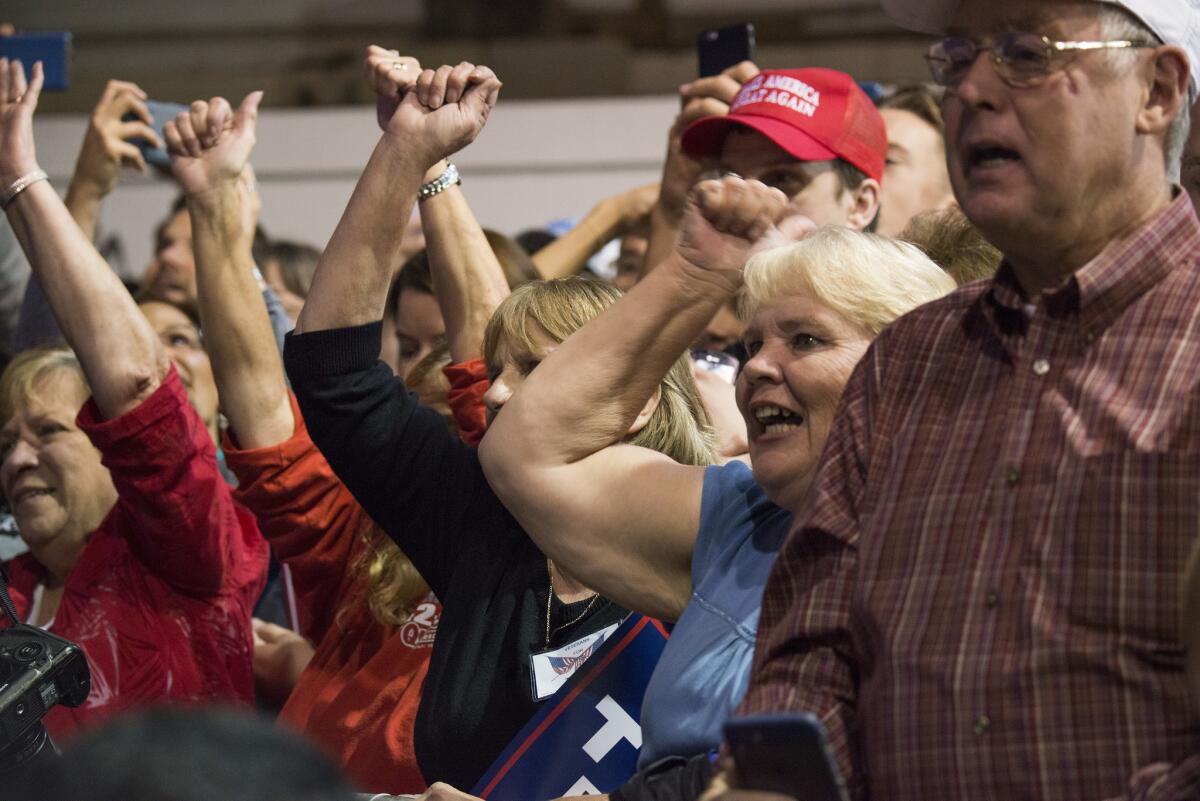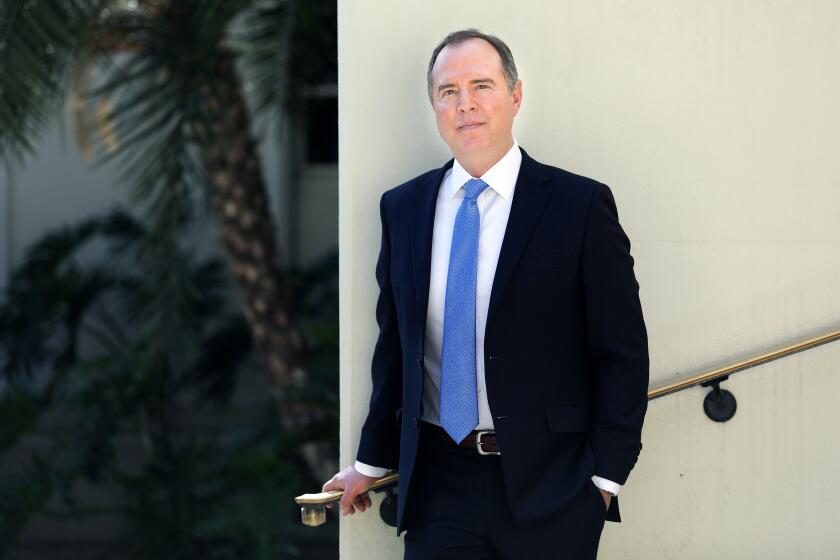Analysis: This election is much more than Trump vs. Clinton. It’s old America vs. new America

- Share via
Reporting from Delaware, Ohio — The contrast in the 2016 presidential election was as evident Thursday as it has ever been: Donald Trump spoke to a largely white audience in Ohio, a state that has traditionally picked presidents but finds itself somewhat marginalized this year.
Soon after, Michelle Obama, the nation’s first African American first lady, campaigned for Hillary Clinton in Arizona, a state where Latinos have changed the political environment so much that Republicans may well lose there for only the second time since 1948.
The dramas surrounding the Trump campaign have sometimes obscured an underlying reality of 2016: Trump and Clinton are running for the same job, but they are talking to and being sustained by two different Americas.
There’s the old one — a distinction not of age alone, but cultural perspective and outlook — that Trump appeals to as he courts white, rural voters and social conservatives. His support base is heavy with voters uneasy with the turns the country has taken in recent years and, broadly speaking, more comfortable with an era when white men like Trump ran things.
And there’s the new America, the one Hillary Clinton has homed in on with her appeals to women, gay and lesbian Americans, the young, and minorities.
Clinton is not a perfect representative of that new America — in part because of her long tenure on the political scene. But the themes on which she has conducted her campaign and popular surrogates like the Obamas have helped shore up her connection. So, too, has her historic reach to become the first woman president.
The focuses of the two candidates echo their parties’ strengths —Republicans with older and whiter voters, Democrats with younger, more culturally and racially diverse ones.
Their slogans also show their aim: Clinton’s is “Stronger Together,” an appeal to the patchwork of groups, many of them flexing new political muscle, that make up her base. Trump’s is “Make America Great Again,” a proposition that harks back to a time when a different, more homogeneous order prevailed.
Trump has never identified his target era, but his cultural references seem to push back decades. Thursday, at a rally in Delaware, Ohio, in a conservative and partly rural area north of Columbus, he brought up “The $64,000 Question,” a quiz show that went off the air in 1958.
In Arizona, before a diverse crowd of thousands, the first lady evoked groups that were often ignored in that era as she delivered a ringing speech on behalf of Clinton.
“We are a nation built on differences, guided by the belief that we are all created equal,” she said. “Hillary knows that our country is powerful and vibrant and strong, big enough to have a place for all of us and that each of us is a precious part of the great American story.”
At his rally, Trump spoke, as he almost always does, to a crowd made up almost completely of white voters. In what has become a common refrain, he framed the election in apocalyptic terms: “Either we win this election or we are going to lose this country,” he said.
My family came here for opportunity, and Donald Trump is taking that away. He’s taking America out of America.
— Omeliah Nembhard
To his followers, that threat is all too real. Judy Krauss, a 70-year-old retired teacher who attended the Trump rally, said she worries that “leftist liberals” are changing America for the worse.
“They’re already in the schools, already in the media, already in the Republican Party,” she said.
Michelle Churma, wearing a pin on her shirt with an image of a machine gun and the phrase “Plead the Second” — a reference to the 2nd Amendment — said she feared the country would go “in an awful direction” if Clinton is elected.
“There’s an America that holds fast to the Constitution … the idea that everyone has an equal chance,” she said. The other believes “everyone has to have the same stuff … the government owes me.”
Earlier this fall, at a shopping mall not far from the rally site, representatives of the other America spoke of their discomfort with Trump.
“We’re married; he’s not OK with that,” said Terri Glimcher, 60, of Powell, Ohio, as she sat in the food court with her wife, Tammy McKey. They were able to marry after the Supreme Court legalized gay unions last year. “He wants to overturn that. And that’s scary.”
Downstairs in another part of the mall, Omeliah Nembhard, 21, said that she was no big fan of Clinton but that Trump struck at the fears of her immigrant family, which moved here from Jamaica.
“My family came here for opportunity, and Donald Trump is taking that away,” she said. “He’s taking America out of America. “
The version of America seen at the ballot box has changed dramatically over the years.
Only a generation ago, in the 1992 election, according to statistics kept by the U.S. Election Project, more than 87% of the electorate was white. By 2012, that figure had fallen to 74%.
Rising most rapidly, and expected to rank even higher in November, are Latino and Asian voters. The Pew Research Center estimated a 17% jump in eligible Latino voters between 2012 and 2016, with a potential 16% increase in Asian voters. The number of eligible white voters was expected to rise a mere 2%.
Where the demographics are headed is undeniable. By 2065, according to another Pew study, only 46% of the American population will be white, down from 62% last year. All told, Latinos, blacks and Asians will make up 51% of the country. While voting performance lags because those populations are younger, they will inevitably be eligible to vote.
The Republican Party, in a report written after the 2012 presidential election, acknowledged that the party had a problem due to the changing face of the nation.
“The nation’s demographic changes add to the urgency of recognizing how precarious our position has become,” said the report by the Republican National Committee. “America is changing demographically, and unless Republicans are able to grow our appeal,” it said, “the changes tilt the playing field even more in the Democratic direction.”
In this campaign, the different Americas have played out not only in the crowds attending the candidates’ rallies but the topics emphasized by the presidential rivals.
Trump speaks of “law and order” and respect for law enforcement. Clinton praises police, but also proposed a plan to help prevent the shootings of young minority men.
Trump talks about the need to curb illegal immigration and ominously suggests that Islamic terrorists have developed a “Trojan horse” to cross the border into this country. Clinton talks of divided families and the need for immigration reform to bring out of the shadows those here illegally.
Wednesday night’s debate underscored the candidates’ loyalties from the first question, about the Supreme Court. Clinton in a matter of two minutes mentioned women’s rights, the gay and lesbian community and her desire to change the rules regarding campaign financing, a favorite issue among young voters.
Election 2016 | Live coverage on Trail Guide
“We stand up and basically say: The Supreme Court should represent all of us,” she said.
Trump, after mentioning a dust-up with Justice Ruth Bader Ginsburg, stressed his desire for the court to uphold the 2nd Amendment, which he described as “under absolute siege.” He indicated he did not support any of the gun restrictions supported by Clinton, even those that command large majorities among Americans.
He also objected to abortion rights — later saying he hoped that the landmark Roe vs. Wade decision would be overturned.
They were speaking about the court and to the two Americans, one powerful in the past, the other reaching for power in the present.
Decker reported from Las Vegas and Bierman from Delaware, Ohio.
Twitter: @cathleendecker
ALSO
Analysis: Donald Trump undoes his third and best debate performance in just a few words
After all three debates, our analysts say Clinton emerged victorious
Updates on California politics
More to Read
Get the L.A. Times Politics newsletter
Deeply reported insights into legislation, politics and policy from Sacramento, Washington and beyond. In your inbox three times per week.
You may occasionally receive promotional content from the Los Angeles Times.











